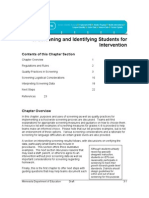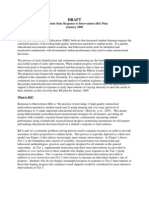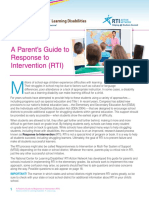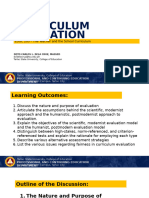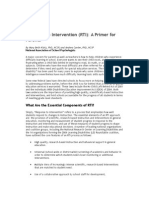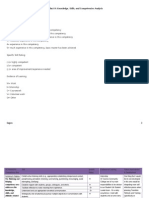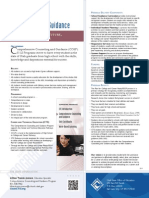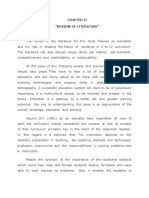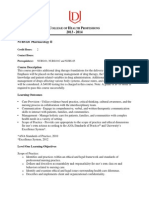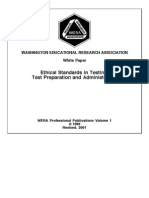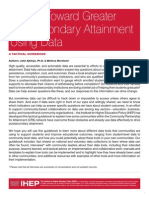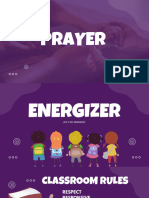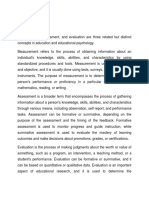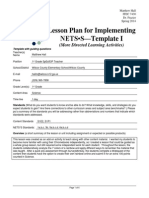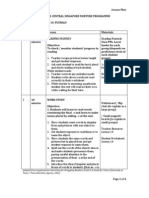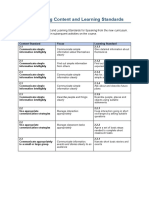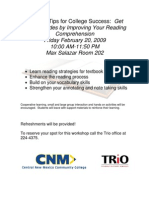What Is Rti Placemat
What Is Rti Placemat
Uploaded by
api-281038377Copyright:
Available Formats
What Is Rti Placemat
What Is Rti Placemat
Uploaded by
api-281038377Original Title
Copyright
Available Formats
Share this document
Did you find this document useful?
Is this content inappropriate?
Copyright:
Available Formats
What Is Rti Placemat
What Is Rti Placemat
Uploaded by
api-281038377Copyright:
Available Formats
National Center on Response to Intervention
What Is RTI?
Multi-Level Prevention System
Essential Components of RTI
Screening
Purpose: Identify students who are at risk of poor learning outcomes
Primary Level
Focus: All students
Setting: General education classroom
Instruction: District curriculum
and instructional practices that are
evidence-based; aligned with state
or district standards; incorporate
differentiated instruction
Assessments: Screening,
continuous progress monitoring,
and outcome measures
Focus: All students
Tools: Brief assessments that are valid, reliable, and demonstrate diagnostic
accuracy for predicting learning or behavioral problems
Timeframe: Administered more than one time per year (e.g., fall, winter, and spring)
Progress Monitoring
Secondary Level
Purpose: Monitor students response to primary, secondary, or tertiary
instruction in order to estimate rates of improvement, identify students
who are not demonstrating adequate progress, and compare the efficacy of
different forms of instruction
Instruction: Targeted, supplemental Assessments: Progress
monitoring, diagnostic
instruction delivered to small groups
Focus: Students identified through screening as at risk for poor learning outcomes
Focus: Students identified through Setting: General education classroom
or other general education location
screening as at risk for poor
within the school
learning outcomes
Tools: Brief assessments that are valid, reliable, and evidence-based
Timeframe: Students are assessed at regular intervals (e.g., weekly, biweekly,
or monthly)
Tertiary Level
Focus: Students who have not
responded to primary or secondary
level prevention
Setting: General education classroom
or other general education location
within the school
Instruction: Intensive, supplemental
instruction delivered to small groups
or individually
Assessments: Progress
monitoring, diagnostic
Tertiary level
of prevention
Each prevention level may,
but is not required to, have
multiple tiers of interventions.
Secondary
level of
prevention
Primary level
of prevention
Data-Based Decision Making
Defining RTI
Data analysis is at all levels of RTI implementation (e.g., state, district, school, grade
level) as well as all levels of prevention (e.g., primary, secondary, tertiary)
Establish routines and procedures for making decisions
RTI integrates assessment and intervention within a school-wide, multi-level
prevention system to maximize student achievement and reduce behavior problems.
Explicit decision rules for assessing student progress (e.g., state and district
benchmarks, level and/or rate)
With RTI, schools identify students at risk for poor learning outcomes, monitor
student progress, provide evidence-based interventions, and adjust the intensity
and nature of those interventions based on a students responsiveness.
Data is used to compare and contrast the adequacy of the core curriculum and
the effectiveness of different instructional and behavioral strategies
RTI may be used as part of the determination process for identifying students
with specific learning disabilities or other disabilities.
Implementing the RTI Framework
Select and implement evidence-based practices and procedures
RTI as a Preventive Framework
RTI is a multi-level instructional framework aimed at improving outcomes for all students.
RTI is preventive and provides immediate support to students who are at risk for
poor learning outcomes.
www.rti4success.org
Implement essential components and identified framework with integrity
Ensure that cultural, linguistic, and socioeconomic factors are reflected in the
RTI framework and its components
National Center on Response to Intervention
1000 Thomas Jefferson Street, NW
Washington, DC 20007
Phone: 8777844255
Fax: 2024036844
Web: http://www.rti4success.org
Additional Contacts:
Center on Instruction: www.centeroninstruction.org
IDEA Partnership: www.ideapartnership.org
RTI Action Network: www.rtinetwork.org
About the National Center on Response to Intervention
Through funding from the U.S. Department of Educations Office of
Special Education Programs, the American Institutes for Research
and researchers from Vanderbilt University and the University
of Kansas have established the National Center on Response to
Intervention. The Center provides technical assistance to states
and districts and builds the capacity of states to assist districts in
implementing proven response to intervention frameworks.
This document was produced under U.S. Department of Education, Office of Special Education Programs Grant No. H326E070004 to the American Institutes for Research. Grace Zamora Durn and Tina Diamond served as the project officers. The views expressed herein do not necessarily
represent the positions or polices of the Department of Education. No official endorsement by the U.S. Department of Education of any product, commodity, service or enterprise mentioned in this publication is intended or should be inferred. This product is public domain. Authorization
to reproduce it in whole or in part is granted. While permission to reprint this publication is not necessary, the citation should be: National Center on Response to Intervention (June 2010). What is Response to Intervention (RTI). Washington, DC: U.S. Department of Education, Office of
Special Education Programs, National Center on Response to Intervention.
You might also like
- K To 12 Grade 4 Learner's Material in Science (q1-q4)Document339 pagesK To 12 Grade 4 Learner's Material in Science (q1-q4)Reynaldo Juanito Ludo Laforteza83% (66)
- Lesson Plan TensesDocument3 pagesLesson Plan TensesKainat Siddique - 85201/Officer Parent Relations/BSEY100% (10)
- Lac-Plan-2019-Esp-Submitted FinalDocument5 pagesLac-Plan-2019-Esp-Submitted Finalrc100% (14)
- Lesson Plan in Handicraft Production Grade 7Document2 pagesLesson Plan in Handicraft Production Grade 7Stephanie Kcel PilapilNo ratings yet
- What Is Rti 2010 07 14 PlacematDocument2 pagesWhat Is Rti 2010 07 14 Placematapi-259562978No ratings yet
- Rti Brochure For ParentsDocument2 pagesRti Brochure For Parentsapi-202351147No ratings yet
- RtiiDocument2 pagesRtiiapi-264115497No ratings yet
- RtiiDocument16 pagesRtiiapi-254465169No ratings yet
- Rti Qa 1Document7 pagesRti Qa 1api-264019256No ratings yet
- Pfes Rtiguide 7 14 11Document28 pagesPfes Rtiguide 7 14 11api-95400001No ratings yet
- ParentbrochureDocument2 pagesParentbrochureapi-202351147No ratings yet
- Parent Brochure Rti - KrolikowskiDocument2 pagesParent Brochure Rti - Krolikowskiapi-202351147No ratings yet
- Q+33&42%# (@&$#'%G&3% (2D (R50:#%+23 (@'#D% ( H - (Document24 pagesQ+33&42%# (@&$#'%G&3% (2D (R50:#%+23 (@'#D% ( H - (David RitterNo ratings yet
- EDU104-UNIT-5Document10 pagesEDU104-UNIT-5Angel HadiaNo ratings yet
- RtI Newsletter Volume 2Document3 pagesRtI Newsletter Volume 2Kip PygmanNo ratings yet
- West Virginia Path To College: A Bridging Research To Practice Event PresentationDocument46 pagesWest Virginia Path To College: A Bridging Research To Practice Event PresentationCNAEducationNo ratings yet
- 9) How Do Formative and Summative EvaluationDocument10 pages9) How Do Formative and Summative EvaluationRichard SooriaNo ratings yet
- Information For Parents: Response To InterventionDocument2 pagesInformation For Parents: Response To InterventionJanna Phillips KennedyNo ratings yet
- Rti State Plan 12-11-07Document10 pagesRti State Plan 12-11-07Rochelle TurnerNo ratings yet
- Standardized Assessment Testing EducationDocument4 pagesStandardized Assessment Testing EducationShopnil SarkarNo ratings yet
- ParentsguidertifinalDocument20 pagesParentsguidertifinalapi-450394002No ratings yet
- Kittle - Rti Teacher BrochureDocument2 pagesKittle - Rti Teacher Brochureapi-202351147No ratings yet
- Chapter 7 Curriculum Evaluation 1Document65 pagesChapter 7 Curriculum Evaluation 1kaedesandovalNo ratings yet
- Response To InterventionDocument5 pagesResponse To Interventionapi-271284612No ratings yet
- Artifact HDocument14 pagesArtifact Hapi-252524549No ratings yet
- CounselingcoverDocument2 pagesCounselingcoverapi-257374427No ratings yet
- Master Checklist of Program ElementsDocument5 pagesMaster Checklist of Program Elementsapi-255677300No ratings yet
- EMGT 340 - MT Exam Castillo, GMDocument3 pagesEMGT 340 - MT Exam Castillo, GMGodoy FamilyNo ratings yet
- Rti MiddleDocument26 pagesRti Middleapi-282893469No ratings yet
- Goals & Outcomes of InstructionDocument27 pagesGoals & Outcomes of InstructionYasmeen JafferNo ratings yet
- Chapter I1 - 2Document6 pagesChapter I1 - 2Christian KimNo ratings yet
- Fact Sheet With CommentsDocument6 pagesFact Sheet With Commentsapi-294234192No ratings yet
- Evaluation Methods PDFDocument5 pagesEvaluation Methods PDFAlliah CasingNo ratings yet
- Weebly - Response To Intervention RtiDocument16 pagesWeebly - Response To Intervention Rtiapi-279177543No ratings yet
- DPI Report On WCPSS IDEA ComplianceDocument10 pagesDPI Report On WCPSS IDEA ComplianceKeung HuiNo ratings yet
- Educational Programmes - 221026 - 164953Document6 pagesEducational Programmes - 221026 - 164953Talari JyothiNo ratings yet
- Beyond Test Scores: Leading Indicators For EducationDocument34 pagesBeyond Test Scores: Leading Indicators For EducationRuslan ZhivkovNo ratings yet
- Response To Intervention: New Roles For School Social WorkersDocument4 pagesResponse To Intervention: New Roles For School Social WorkersYashaswini YashuNo ratings yet
- Evaluation in Nursing PDFDocument29 pagesEvaluation in Nursing PDFMichael CabreraNo ratings yet
- Response To Intervention RtiDocument7 pagesResponse To Intervention Rtiapi-360009831No ratings yet
- Naspa Acpa Comptency AnalysisDocument11 pagesNaspa Acpa Comptency Analysisapi-245950103No ratings yet
- Kittle - Rti Parent BrochureDocument2 pagesKittle - Rti Parent Brochureapi-202351147No ratings yet
- Artifact E1 041516 1643Document13 pagesArtifact E1 041516 1643api-310911911No ratings yet
- Report For Psych Assessment ScriptDocument5 pagesReport For Psych Assessment ScriptAling inengNo ratings yet
- Nurs126 Fullsyllabus 2014 Parts12Document9 pagesNurs126 Fullsyllabus 2014 Parts12api-254149267No ratings yet
- Measure - ElmwoodDocument5 pagesMeasure - Elmwoodapi-257829203No ratings yet
- Wixson Et Al-2011-The Reading TeacherDocument4 pagesWixson Et Al-2011-The Reading Teacherapi-190626879No ratings yet
- Assessment of Learning 2 IntroductionDocument3 pagesAssessment of Learning 2 IntroductionMary Grace Coquilla50% (2)
- UntitledDocument80 pagesUntitledExpressNo ratings yet
- Mtss Parent Explanation Letter 2015-16-Long VersionDocument2 pagesMtss Parent Explanation Letter 2015-16-Long Versionapi-110894488No ratings yet
- WERA Test EthicsDocument11 pagesWERA Test EthicsKen DobsNo ratings yet
- Day 1-RBM&EDocument54 pagesDay 1-RBM&EKaka SuleNo ratings yet
- Day 3-RBM&E PPTDocument150 pagesDay 3-RBM&E PPTKaka SuleNo ratings yet
- 語測評W3 ReflectionDocument5 pages語測評W3 ReflectionHulu ViNo ratings yet
- MET - Feedback For Better Teaching - Principles PaperDocument12 pagesMET - Feedback For Better Teaching - Principles PaperBudulan RaduNo ratings yet
- IHEP Final VersionDocument58 pagesIHEP Final VersionFrankChiNo ratings yet
- LT 11 17Document16 pagesLT 11 17KevinOhlandtNo ratings yet
- MeasureDocument6 pagesMeasureapi-257656254No ratings yet
- Test or Examination Is AnDocument3 pagesTest or Examination Is AnJacquelyn MendozaNo ratings yet
- Educ 4. Assessment in Learning. Unit 1Document73 pagesEduc 4. Assessment in Learning. Unit 1Jake GopitaNo ratings yet
- WCES 2014 SI Plan January Submission Part 2 SchoolwideDocument24 pagesWCES 2014 SI Plan January Submission Part 2 SchoolwidecrissyjolleyNo ratings yet
- Aiou FileDocument16 pagesAiou Fileumer100% (1)
- Is It Working in Your Middle School?: A Personalized System to Monitor Progress of InitiativesFrom EverandIs It Working in Your Middle School?: A Personalized System to Monitor Progress of InitiativesNo ratings yet
- The Practical Guide to RTI: Six Steps to School-Wide Success: Six Steps to School-wide SuccessFrom EverandThe Practical Guide to RTI: Six Steps to School-Wide Success: Six Steps to School-wide SuccessNo ratings yet
- Lesson Plan - Final EvenDocument4 pagesLesson Plan - Final Evenapi-302003110No ratings yet
- Hallm - 7430 Lesson PlanDocument6 pagesHallm - 7430 Lesson Planapi-252982887No ratings yet
- CBC BPP PresentationDocument24 pagesCBC BPP PresentationRustan Lacanilao0% (1)
- Action Plan MAPEH 2018-2019Document2 pagesAction Plan MAPEH 2018-2019Rodolfo Esmejarda Laycano Jr.94% (36)
- Lesson 14 - PluralsDocument9 pagesLesson 14 - PluralsNurture ProgrammeNo ratings yet
- Edu 201 Final CH 10 Lesson Plan Outline For PresentationDocument9 pagesEdu 201 Final CH 10 Lesson Plan Outline For Presentationapi-356715114No ratings yet
- Universal Design For Learning Lesson PlanDocument2 pagesUniversal Design For Learning Lesson Planapi-321762143100% (2)
- Year 5 Speaking Content and Learning StandardsDocument1 pageYear 5 Speaking Content and Learning StandardsJo Quen ElipNo ratings yet
- Naac Criterion 2,1Document234 pagesNaac Criterion 2,1sangeetadineshNo ratings yet
- Collaborative Learning Lesson PlanDocument2 pagesCollaborative Learning Lesson PlanGladys SaraelNo ratings yet
- Resume Ked 2 1Document2 pagesResume Ked 2 1api-273985023No ratings yet
- Kathryn M. Stoczanyn: Career Objective: Education: UndergraduateDocument2 pagesKathryn M. Stoczanyn: Career Objective: Education: UndergraduateKathryn S.No ratings yet
- B.Ed. Third Semester (C.B.S.) Examination Physics Teaching Compulsory Paper-1 (Group-C: Science-1)Document3 pagesB.Ed. Third Semester (C.B.S.) Examination Physics Teaching Compulsory Paper-1 (Group-C: Science-1)RAHUL GEDAMNo ratings yet
- Transcribed Semi-Detailed Lesson Plan in Team TeachingDocument10 pagesTranscribed Semi-Detailed Lesson Plan in Team TeachingAllyssa Mae De LeonNo ratings yet
- Lesson Critiquing Form For Teaching Internship: My PortfolioDocument3 pagesLesson Critiquing Form For Teaching Internship: My PortfolioAna Marie ValdezNo ratings yet
- Accomplishment Report DTR December 1 30 2021Document4 pagesAccomplishment Report DTR December 1 30 2021rona sumodioNo ratings yet
- THIS IS lONDON - PROIECTDocument5 pagesTHIS IS lONDON - PROIECTNatalia JosanNo ratings yet
- Work Plan in Reading ProgramDocument3 pagesWork Plan in Reading Programbenz cadiongNo ratings yet
- LP 2Document3 pagesLP 2api-734900066No ratings yet
- Reading Comprehension FlyerDocument1 pageReading Comprehension FlyerRoy TurnerNo ratings yet
- Talisay Es Lac Report Form 1 and 2Document4 pagesTalisay Es Lac Report Form 1 and 2Klaris ReyesNo ratings yet
- Phillipines Lesson 2 - Santa ClaraDocument3 pagesPhillipines Lesson 2 - Santa ClaraWinnie NgNo ratings yet
- Current Assessment Trends in Malaysia Week 10Document13 pagesCurrent Assessment Trends in Malaysia Week 10Gan Zi XiNo ratings yet
- Monitoring and Evaluation Form For Mentors: Teacher Induction Program (TIP)Document4 pagesMonitoring and Evaluation Form For Mentors: Teacher Induction Program (TIP)Paul John Berdan100% (2)
- Orientation To Field PlacementDocument16 pagesOrientation To Field PlacementHofstraUniversityNo ratings yet
- Authors of Exhibited Works - Always Green, Always Blue - 2013Document12 pagesAuthors of Exhibited Works - Always Green, Always Blue - 2013Damian IonelNo ratings yet












